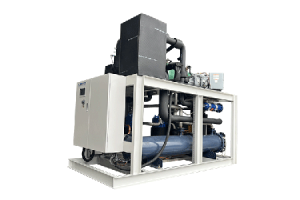Are hydraulic chillers the same as industrial/laboratory chillers?
Hydraulic chillers are not directly equivalent to industrial chillers or laboratory chillers, but they have certain relevance and overlap in function. They are all devices used to provide cooling effects. The main difference lies in the application field and design focus.
The common point is that both emphasize precise control of temperature to meet the requirements of temperature stability in their respective application fields. They are usually equipped with temperature controllers, such as PID controllers, to achieve automatic regulation and control of the temperature of the cooling medium. Both transfer heat through heat exchangers (such as plate heat exchangers, shell and tube heat exchangers, etc.), transfer the heat generated by the equipment or system to the cooling medium, and then discharge it through the refrigeration cycle to achieve the cooling effect. Both rely on circulating pumps to drive the cooling medium (such as water or special coolant) to circulate in the system to ensure continuous heat transfer and uniform cooling.
The difference is that hydraulic chillers are mainly designed for hydraulic systems, used to cool hydraulic oil or other hydraulic media, to ensure that the hydraulic system can be kept within a suitable temperature range during operation, and to prevent problems such as efficiency loss, equipment damage or oil deterioration caused by overheating. Hydraulic chillers usually need to withstand higher pressures, and their design focuses more on system stability, pressure resistance, and cooling efficiency to meet the strict requirements of hydraulic systems for temperature control.
Laboratory chillers are equipment that is specifically used to cool laboratory equipment such as rotary evaporators, lasers, nuclear magnetic resonance instruments, mass spectrometers, and other precision instruments. This type of chiller usually emphasizes the accuracy and stability of temperature control, is relatively small in size, easy to operate, and has low noise, making it suitable for placement in a laboratory environment. Laboratory chillers may also have features such as intelligent control and low energy consumption to meet the special needs of scientific research and analytical experiments. According to the cooling method, they are divided into air-cooled and water-cooled types, which are widely used in plastic molding, laser processing, food processing, chemical industry, medicine, and other fields. Their design and configuration are based on the temperature range and cooling capacity requirements of specific industrial applications.
Therefore, although hydraulic chillers and industrial/laboratory chillers fundamentally achieve the purpose of heat exchange and temperature control through circulating cooling media, their respective application scenarios, design features, and performance requirements are different. Hydraulic chillers are more focused on the specific needs of hydraulic systems, while industrial/laboratory chillers are targeted at the broader fields of industrial production and scientific research, respectively.
Water Chiller Air Chiller Oil Chiller
- More
LTZ Inverter M Series
APPLICATIONS Suitable for application to the target temperature control object already has a cold storage tank and a circulating pump, and the medium is transported into the LTZ M series refrigeration temperature control unit through th…
- More
LN -60°C~ -10°C
适用范围 Product Features 产品参数 Product Parameter 行业应用 APPLICATION 航空航天材料|试验装置控温解决方案 在航空航天领域,材料的性能直接关系到飞行器的安全、可靠性和…
- More
LT -80℃~-20℃
It can guarantee 24-hour continuous operation Circulating refrigeration of ethylene glycol mixed with water mixture 1. Can use ethylene glycol mixed with water for circulating refrigeration, saving resources 2.Cir…
- More
- More
LTZ Variable Frequency M series
It is suitable for the target temperature control object that already has a cold storage tank and a circulating pump. The medium is transported to the LTZ M series refrigeration unit through the circulating pump, which is a closed-loop refri…
- More
LTG Screw Chiller Units
It is suitable for various production process cold sources in chemical, pharmaceutical, machinery and other fields, and can provide -110℃~30℃ refrigeration medium, which can be used as ice storage, low temperature air supply and ot…
- More
ZLTZ Efficient Heat Exchanger Series
The ZLTZ temperature control unit is combined with a microchannelreactor to form a high heat release temperature control application.Under the same f…
- More
LT-800 mini chiller
LNEYA mini chiller is a small water chiller use in laboratory for rotary evaporator.
- More
LJ -45°C~ -10°C
Fast cooling and low cooling temperature -5~-150°C Water Cooling LNEYA specializes in the production of single-fluid cryogenic chillers. The refrigeration temperature ranges from -150°C to -5°C, which can mee…
- More
LD -80°C~ -30°C
1.Temperature ranges from -5℃ ~ -150℃, can meet different temperature2. Famous brand semi-closed piston compressor, semi-closed bipolar piston compressor, semi-hermetic screw compressor, main brand are BOCK. Bitzer, Cop…
- More
LT -45℃~30℃
LOW TEMPERATURE COOLING CIRCULATOR For fast liquid cooling 1. Can use ethylene glycol mixed with water for circulating refrigeration, saving resources 2.Circulating pipeline design, prolong t…
- More
LT -60℃~-20℃
Circulating refrigeration of ethylene glycol mixed with water mixture After the medium enters the extraction tank, it must be closed,the sandwich is heated, and the refrigerant is turned on to reducethe heat source of the…
loading…
已经是到最后一篇内容了!
Related recommendations
-
What is a Screw Chiller
1307Screw chillers provide efficient, stable cooling for industrial, commercial, and data center applications. Learn their operation, features, and uses.
View details -
What Is a Chemical Process Chiller
1056Reliable Chemical Process Chillers ensure stable reactions, protect equipment, cut energy use, and improve safety in demanding chemical plants.
View details -
Chiller vs Air Conditioner
696Learn the difference between a chiller and an air conditioner. Discover which suits industrial or comfort cooling for your needs.
View details -
Lab Chiller vs Industrial Chiller
735Learn the real difference between lab chillers and industrial chillers. Understand their temperature control accuracy, cooling capacity, and best applications to help you choose the right system for your needs.
View details
 LNEYA Industrial Chillers Manufacturer Supplier
LNEYA Industrial Chillers Manufacturer Supplier

























